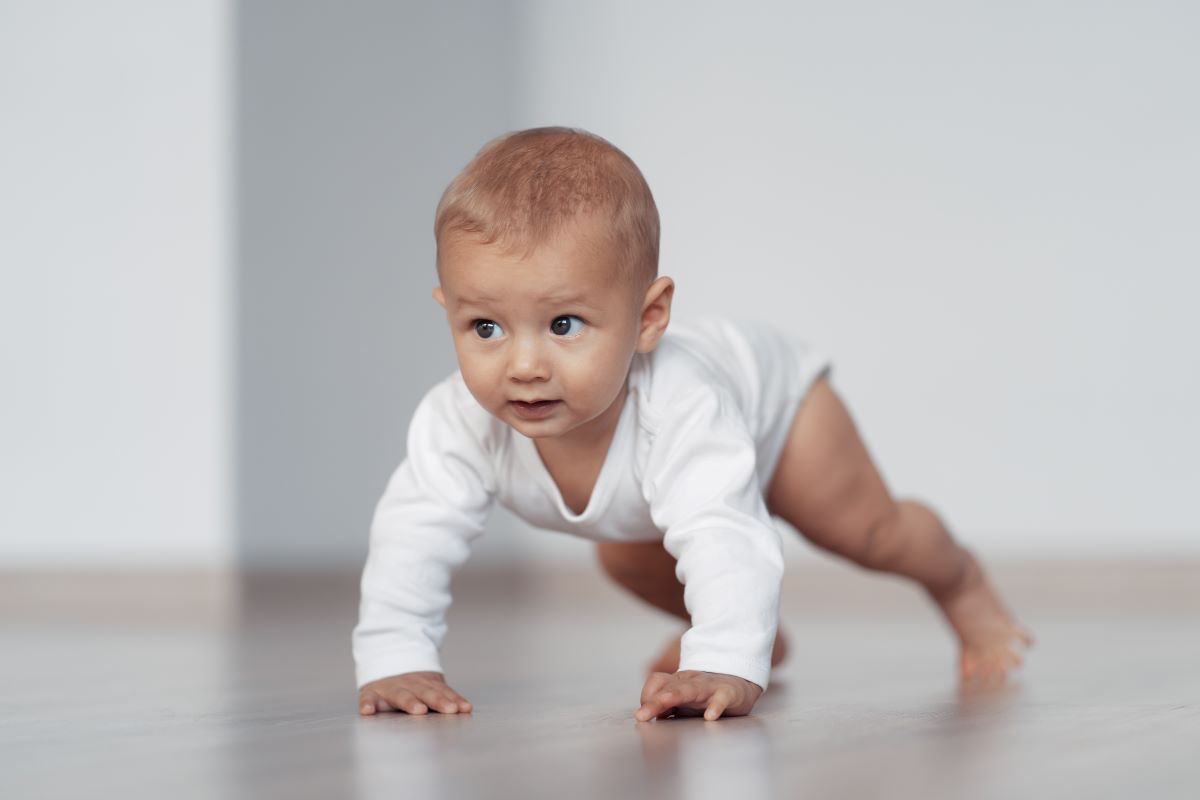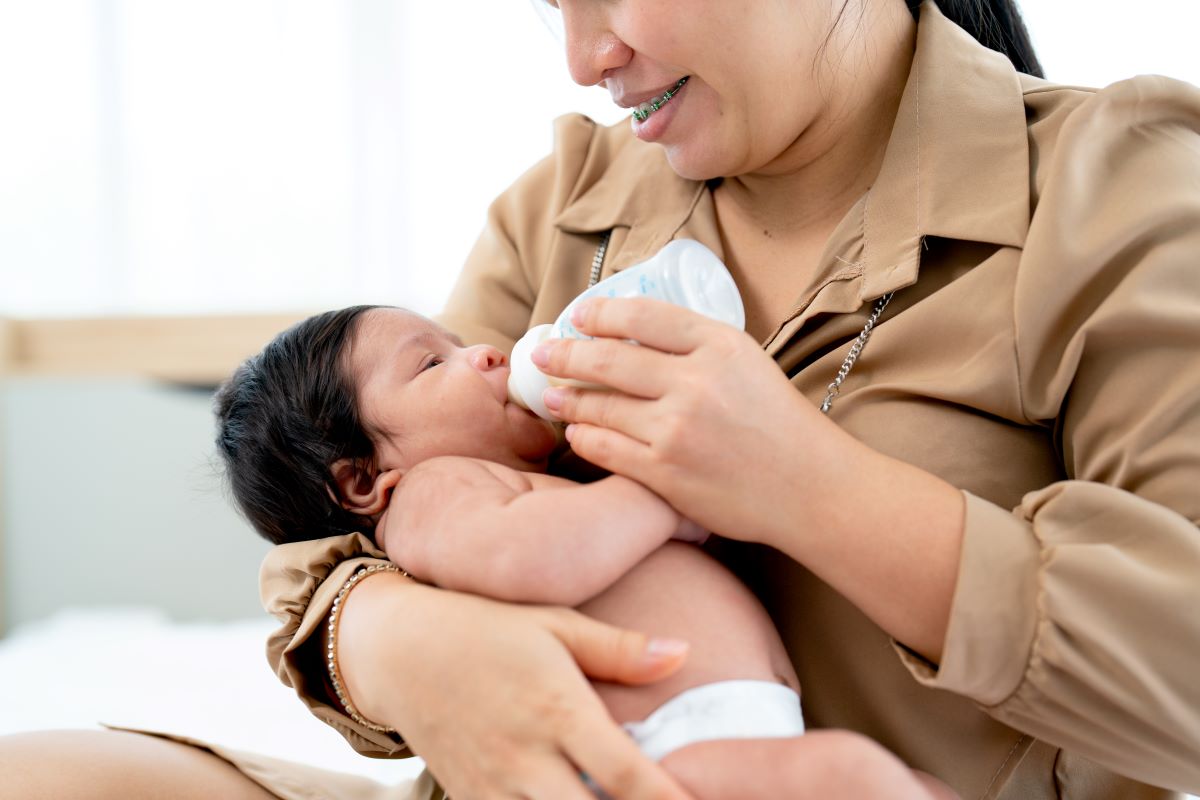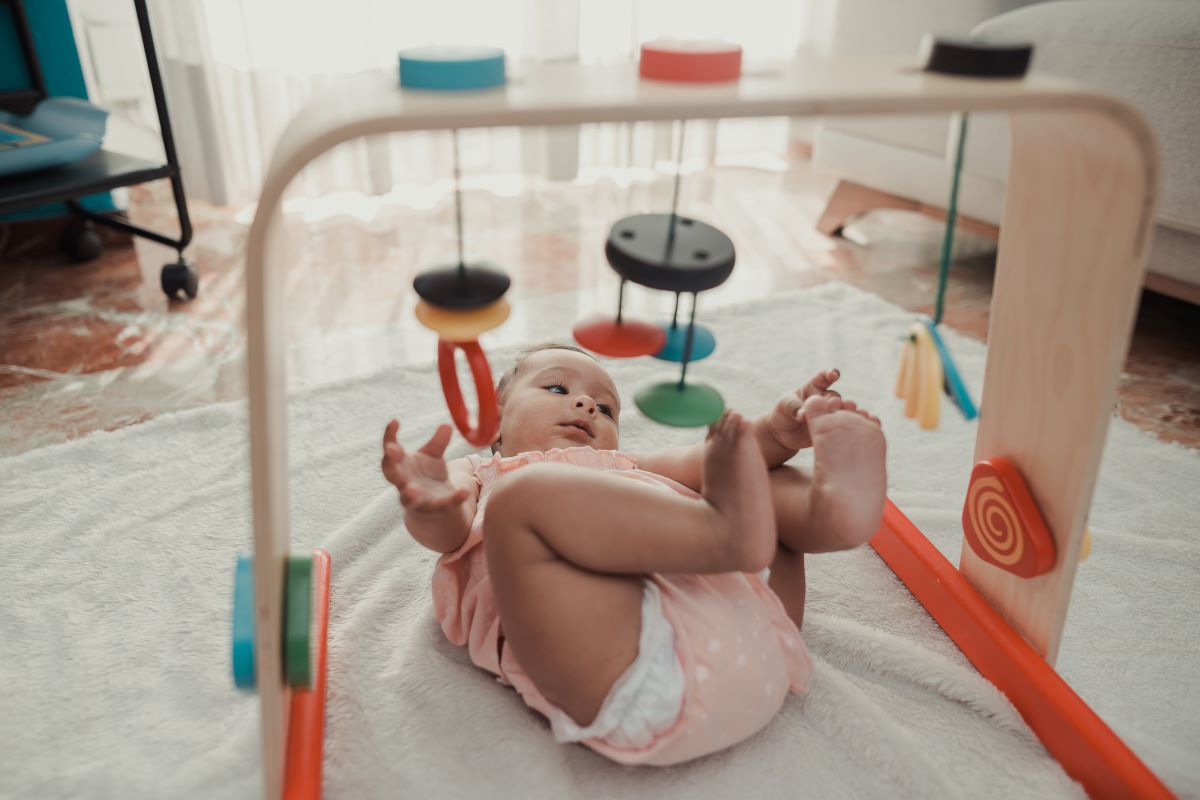Simplifying Life Insurance in India
11 Developmental Milestones of a 2 Month Old Baby

The second month of your baby's life is an exciting time that includes important changes and events. At this stage, your baby is rapidly growing both physically and emotionally, and keeping up with these early changes is critical to understanding how to help your baby develop properly and meet future developmental steps.
Let’s look at tips so that you can track the essential developmental milestones of a two-month-old, learn exciting things for your baby, and understand safe approaches. Read on to learn about these critical earlier stages in the baby's growth.

Table of Contents

What Most Babies Do by 2 Months?
By two months, babies show significant changes in growth, both physically, emotionally, and cognitively. They actively engage with the environment, including people familiar to them. Similarly, voices and gurgles fascinate them instead as a phase of communicative attempts.
You can also notice physical improvements in head control and body coordination of two-month-old infants, especially with the use of the stomach. Cognitively, they start following objects as though looking towards them and responding to known persons. Infants have begun to make sounds, including cooing, as a step forward to speech and verbalisation.
2 Month Milestones & Development Checklist
1. Movement Milestones for a 2 Month Old Baby

Movement Milestones for a 2 Month Old:
- Head Control: During tummy time, the child lifts their head and manages to maintain it when held in a vertical position.
- Arm and Leg Movements: Moves arms and legs with a more synchronised action instead of a jerky action, but with less coordination.
- Tummy Time Progress: They can raise when on their stomach, facilitating upper-body muscle strengthening.
- Grasping Reflex: It still retains a strong grasp reflex, making it easy for babies to hold on to anything from fingers to toys for a few seconds.
- Stretching and Kicking: They stretch and kick often while lying on their backs, which assists in building leg muscles for subsequent actions.
2. Visual and Hearing Milestones for a 2 Month Old Baby

Visual Milestones:
Infants this age develop a considerable amount visually and can track and focus on objects more efficiently.
- Tracking Objects: At that time, the baby will start to track moving objects visually, for example, faces and brightly colourful toys, and will not look at the ceiling all the time.
- Focusing: A baby can look at an object very close up, particularly one that is not more than a foot away.
- Recognising Faces: Begins recognising familiar faces, reacting with alertness and attention to those.
- Increased Awareness: Shows curiosity and focuses on objects in their immediate surroundings, such as ceiling fans or colourful hanging mobiles.
Hearing Milestones:
Babies this age also tend to be more responsive to sounds, good and bad. Here are some of the significant auditory milestones:
- Responding to Voices: Shows signs of recognising familiar voices and may turn toward the sound of their parents and caregivers.
- Startle Reflex: Struggling at loud or unknown noises but may calm quickly when hearing soothing, familiar sounds.
- Cooing: Gurgling sounds advance to more complicated forms, as when babies produce these sounds, they are thinking.
- Sound Localisation: Starts showing the ability to identify the general direction of sounds, moving their head slightly towards them.
3. Smell and Touch Milestones for a 2 Month Old Baby

Smell Milestones:
The 2 month old begins recognising and associating scents. Here are the critical nasal developments of this month:
- Familiar Scents: Babies can recognise their caregiver’s scent, finding comfort in their presence and often calming down when held close.
- Sensitivity to New Smells: They become more aware of new scents in their environment, although their reactions are subtle.
Touch Milestones:
Infants during this period extensively explore through textures using their hands and mouth. Here are some common touch milestones:
- Exploring Textures: Babies start to explore different textures with their hands, though grasping is still reflexive. They may hold onto soft blankets or their caregiver’s fingers.
- Calming Through Touch: Finds comfort in gentle touches, like stroking or swaddling, which helps regulate emotions and provides a sense of security.
- Increased Sensitivity: Shows sensitivity to varying temperatures and textures on their skin, reacting to warmth and cold by moving or facial expressions.
4. Sleep Milestones for a 2 Month Old Baby

2 Month Old Baby Sleeping Patterns:
- Longer Sleep at Night: Starts sleeping a bit longer, deeper and more fulfilling, but not all through the night, usually for around 4 to 6 hours at a time.
- More Consistent Napping: Takes several naps daily, each lasting 1-2 hours. Sleep during the day is still essential for development.
- Establishing a Sleep Routine: Begins adjusting to a more predictable sleep-wake cycle with periods of wakefulness during the day and sleep at night.
- Sleep Cycles: Sleeps in cycles, with deep and lighter sleep phases. This can be occasional twitching or movements during sleep.
5. Health and Growth Milestones for a 2 Month Old Baby

Here’s a chart of health and growth milestones a normal 2 month old baby should attain during that age:
These values represent typical ranges, but individual variations can occur. Regular check-ups with a paediatrician will help ensure your baby is on track with their growth and health.
6. Feeding Milestones for a 2 Month Old Baby

Feeding Milestones for a 2 Month Old:
- Increased Appetite: Infants may feed more often or take in more milk per feeding, going through ‘growth spurts whereby infants get hungrier and may need more food.
- Feeding Duration: 20-40 minutes is the average duration of an individual feed, but there are exceptions. Most babies require feeding after every 2-3 hours.
- Establishing Feeding Routines: Parents may start feeding more regularly, and the baby may utilise correct feeding cues such as putting hands in the mouth.
- Satiety Cues: Begins refusal to suck at the breast/bottle and opposes further feeding by positively mouthing or slowing down the sucking motion.
What to Feed:
During this age, you should be careful with what you feed your infant as it can deeply affect them. Here’s a breakdown of it:
- Breast Milk: Breast milk is still the dominant nutrition, providing all important antibodies, nutrients, and flap fluid.
- Formula: Infants of this age must get well nourishment, and if breastfeeding is not feasible, formula should be able to provide all the nutrients necessary.
- No Solids Yet: Avoid giving any solid food until they are 4 - 6 months old. Hence, they only need breast milk or formula for this age.
Avoid overfeeding. Watch for signs of satiation and avoid pushing the baby to feed more than it needs.
7. Schedule and Routine Milestones for a 2 Month Old Baby

Here is a typical daily routine for a 2 month old:
8. Cognitive Milestones for a 2 Month Old Baby

Cognitive Milestones for a 2 Month Old:
- Exploring Objects: Concentrates on external sound and visual stimuli, and although the grasping reflex is still in action, this ability is still more purposeful.
- Attention span: Able to study one object or face for a concise minute or more, proving the early sentiments awakened in this child.
- Recognising Faces: The child becomes much more aware of other people’s faces, can identify some of them, and even gazes at them encouragingly.
- Early Cause and Effect: Children may show some initial understanding of cause and effect, such as reacting to a parent’s voice or smile.
- Sensory Exploration: They employ their senses to investigate the environment and take an interest in the different textures and sounds.
9. Social Milestones for a 2 Month Old Baby

Social Milestones for a 2 Month Old:
- Social Smiles: Infants at this age can smile back when someone else smiles at them. The start may lead to engagement/interaction with other people.
- Recognising Caregivers: The child can now show preferences, especially towards caregivers’ faces, and become active during these interactions.
- Responding to Voices: They now respond to voices by turning toward them or showing recognition.
- Social Cues: The infant displays the same tendency of trying to engage the caregivers, eventually exhibiting eye contact and being in the early stages of cooing or talking.
10. Language and Speech Milestones for a 2 Month Old Baby

What to Expect:
- Vocalisations: Begins making cooing sounds and experimenting with different vocalisations, such as “oo” or “ah.”
- Early Cooing: They will begin cooing and possibly do early types of babbling, but they will still need to have meaningful words.
- Responding to Sounds: They will be more observant of familiar sounds or voices, turning their heads in that direction.
- Listening and Reacting: At this stage, they are expected to move their body or legs in response to a change of tone in voice or shift of pitch.
These early sounds and reactions are the basis for later language development and indicate growing communication skills.
11. Fine Motor Milestones for a 2 Month Old Baby

Fine Motor Milestones for a 2 Month Old:
- Grasp Reflex: The strong grasp reflex persists. When one places an object in the palm, the infant grasps or holds on to the object.
- Visual Tracking: Their hand-eye coordination has improved, as they can better track moving things with their eyes.
- Hand Movements: The infant begins to move their hands more slowly from one side to the other, but these movements are still quite jerky and reflexive.
- Increased Reach: The infant starts to look for and reach for objects within his or her visual field; these understandings of manipulating objects are still developing.
What are the Activities for a 2 Month Old?

1. Tummy Time
Make your baby lie down on the tummy for neck, shoulder, and arm development. This promotes using core muscles and motor skills since babies will try to push their heads upwards and get up from a lying position while on their bellies.2. Gentle Play with Soft Toys
Incorporate soft, colourful toys to enhance visual and emotional engagement. Gentle play, including soft shakes and movements of the toy, encourages reaching and grasping and enhances sensory development.3. Face-to-Face Interaction
Make eye contact, smile, speak, and sing to your baby. These actions also help the child's emotional and social growth, as they can recognise people and respond to their voices.4. Listening to Soft Music or Singing
Play calming songs or sing to your baby as much as possible. This introduces many kinds of sounds and beats for aural development while providing a soothing experience for your baby, especially during bedtime.5. Reading Simple Books
While reading picture books, you should read out loud as you turn pages. This exposes your infant to the preverbal melody and rhythm of the language, preparing their language and vision development.6. Exploring Different Textures
Use soft fabrics or textured toys to introduce various textures during playtime and immediate surroundings. This sensory exploration helps develop your baby’s sense of touch and supports cognitive and sensory development.7. Mirrors
A babyproof mirror should be positioned where the child can see themselves. This helps them understand their movements further and hence enhances their social and visual awareness.8. High Contrast Toys
Use toys with high-contrast patterns and colours during playtime. These are easier for your baby to see and stimulate visual development, which is still developing at this age. This also aids with their attention span and cognitive development.9. Gentle Rocking or Swaying
A slight rock or swaying motion when holding a baby in a carrier is a soothing activity. Such a motion strengthens the baby's sense of balance and orientation, while promoting comfort and relaxation.
These activities help your baby understand the world around them and thereby foster their growth, laying the groundwork for later milestones.
What are the Safety Tips for a 2 Month Old Baby?
In the case of a baby of just two months, looking after them requires close proximity and cautiousness to keep them safe. Here are some safety tips necessary at this stage:
Savings & Protection Options for Your Child
How to Support a Baby's Development at 2 Months?
1. Providing Sensory Stimulation
You should also give your baby different toys in different colours, patterns, and textures for stimulation. Sensory toys are mainly used for visual and tactile exploration and to develop fine motor and cognitive skills as the toys are shaped and sounded differently.2. Talking and Reading to Them
Involve your baby in verbal activities such as talking to them, singing to them, and reading picture books, primarily board books. It assists in aiding the child’s language and cognitive development, rehabilitating skills, and embassies the mother-child relationship.3. Encouraging Movement
Promote your baby’s physical growth by including playing tummy time and helping them gently reach out to the toys. The activities assist in the development of neck and shoulder muscles, core stability, and hand-eye coordination.4. Introducing Gentle Stimulation
Use colours and starkly contrasting toys and objects to attract your baby's attention. This visual stimulation also assists the baby’s sensory development by allowing them to focus on objects, thus promoting early visual and cognitive abilities.5. Facilitating Social Interaction
Spend time making eye contact, smiling, and reacting to the baby’s coos and sounds. This interaction helps form social and emotional development. It is also where they learn some of the social cues and bonds.6. Offering Safe, Comforting Environments
Always make sure that the baby’s surroundings are quiet and safe. Soft music or gentle rocking can thus condition them to calm down, help regulate the child’s emotions, and stabilise their sleep cycles using such techniques.7. Encouraging Sensory Exploration
Make it a point to let your baby explore the texture and the sounds through safe-allowed toys and other objects. This sensory exploration plays a supportive role that is cognitive and further develops the baby’s ability to comprehend their environment.8. Supporting Sleep Patterns
To promote your baby’s good sleeping habits, help them by ensuring a consistent schedule for putting them to bed. A set timetable leads to good sleep practices, an important aspect of growth.9. Fostering Emotional Security
Whenever the baby makes a demand, make sure that you help the baby immediately and act for the baby if it is troubled. One of the greatest foundations of emotional development is creating a strong sense of security, which enables babies to feel safe around their caregivers.When to Talk to the Paediatrician?
It is advisable to contact the paediatrician if there is any issue with the health assessment and development of the 2 month old infant. Here are some conditions under which the healthcare provider consultations are done:
- If your baby does not react to your voice, tense their arms/ limbs towards you, try to make eye contact, or if they are not starting to follow objects in front of them.
- If your baby has lost skills, like lifting their head during tummy time or making cooing sounds, it’s essential to address this with your paediatrician.
- In case you have problems with the proper nourishment of the baby – be it latching on or the weight gain – do it properly, or there are other signs of reluctance to eat.
- Chronic sleep problems for newborns include the inability to fall asleep, frequent waking up in the middle of the night, and difficulty maintaining a consistent sleep routine.
- An extremely fussy baby with a hard tummy who does not pass stool or seems uncomfortable requires that you see your doctor to rule out an infection.
- Talking to your paediatrician can provide support if you feel overwhelmed, anxious, or have concerns about your baby’s overall well-being at any time.
FAQs about 2 Month Developmental Milestones
What are typical physical milestones for a 2 month old?
What are the social and emotional developments of a 2 month old baby?
How can I support my baby’s cognitive development at two months?
What are common sleep patterns for a 2 month old?
What feeding patterns should I expect in 2 months?
How often should my 2 month old have tummy time?
What are some signs of developmental delays at 2 months of age?
How can I help my baby develop better head control at 2 months?
What are the best activities for a 2 month old?
What should I do if my 2 month old baby seems unusually fussy?
What do babies at 2 months see?
Does a 2 month old know their mom?
What is normal behaviour for a 2 month old baby?
How do I know if I'm overfeeding my 2 month old?
What is the average weight for a two month old baby?
How to play with a 2 month old baby?
How much milk is needed for a 2 month old baby?
What should a 2 month old baby be doing developmentally?
How far can a baby see at 2 months?
Important Articles about Infant Developmental Milestones




















